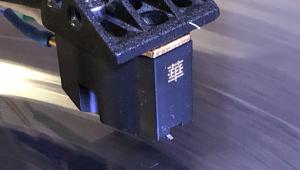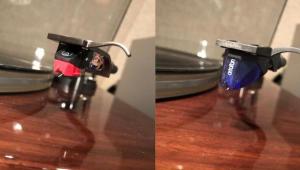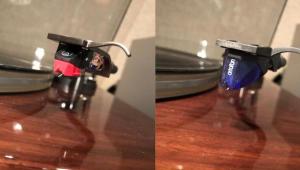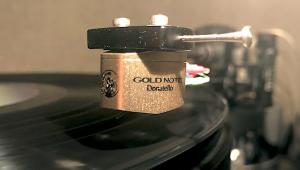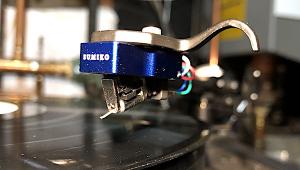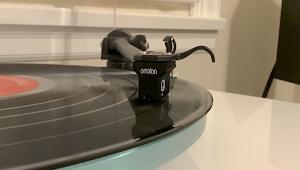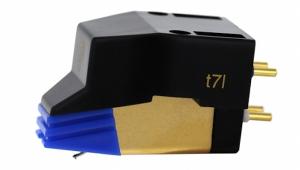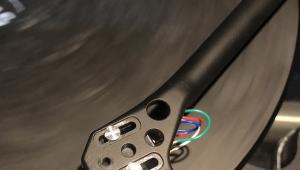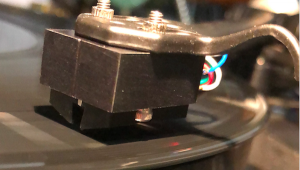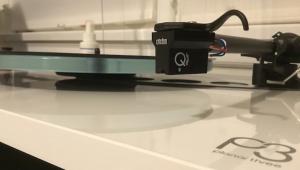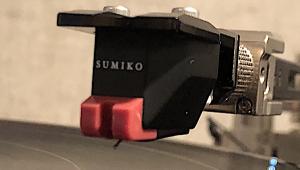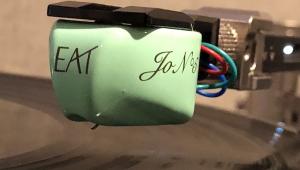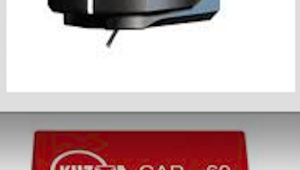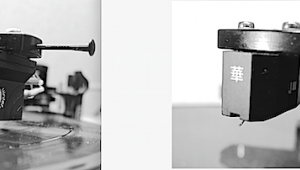Sumiko Triple Play: Three New Cartridges—Blue Point No 3 Low and High Output and Celebration 40

Both versions of the Blue Point 3 feature 0.3 x 0.7 mil elliptical styli attached to an aluminum cantilever and feature coils of “high purity” copper. The output differences, 2.5mV for the high output version and .5mV for the low output version (both @1kHz) result from the number of copper coil turns on the former, which also affects internal impedance.
The high output version’s is 135 ohms verses the low output’s 28 ohms (still relatively high in today’s world of ultra-low impedance MCs). The HO version has the default 47kOhm load impedance versus the low output version’s recommended loading being >100 Ohms. Otherwise, the specs are identical, and the two units look identical as well. Frequency response is 13Hz-35kHz, channel separation is rated at 30dB@1kHz, Balance is <1dB@1kHz, compliance is 12x10-6cm/dyn@100Hz. VTA is 20 degrees, and tracking force range is 1.8-2.2 grams.
As with the less costly Blue Point updates the Celebration 40 is a revised version of a previously available cartridge (in this case the Pearwood Celebration II), which now includes the same long-grain boron cantilever/ 75µm x 2.5µm Microridge stylus assembly used in Sumiko’s flagship Palo Santos Presentation.
That’s a big deal. Much of the rest of the construction remains as before: a milled Teflon backplate and the same generator system fixed to a machined aluminum cradle, both for maximum rigidity and minimum resonance. The new Celebration fits into a snazzy looking plumwood body and like the older pearwood design does not include a stylus guard so this is not the cartridge for cat lovers, curious kids or overzealous cleaning people unless you have a dustcover or a removeable head shell and take care to remove it between plays.
Set Up and Listing
I set up the low output Blue Point 3 on the Acoustic Signature Monaco Neo turntable ($50,000) equipped with the TA-7000 NEO tone arm ($15,999) and ran it through Hegel’s ridiculously great V10 MM/MC phono preamplifier ($1500—review coming shortly). Yes, you could say “ridiculous overkill” but to paraphrase what Rummy famously said, “You go with the turntable you have, not the turntable you might want or wish to later have”. The Monaco NEO/ TA-7000NEO will be on an upcoming Stereophile cover.
I installed the HO Blue Point 3 on the budget Dual CS 518 ($799—review coming shortly). The Dual comes with a $99 Ortofon 2M Red so you could say putting $500 cartridges on $67,000 and $800 front end rigs are mismatches but the results said otherwise.
Finally, I put the Celebration 40 on the SAT CF1i-09 arm/ SAT XD-1 turntable combo, which costs more than $250,000. Again, you could say “ridiculous overkill” putting a $2799 cartridge on that rig or you could say it’s “ridiculous overkill” no matter what cartridge you put on that turntable. But then you’ve probably never heard it.
Using the Ortofon test record, the LO Blue Point 3 cleanly tracked the 60µm peak at 2.0 grams but there was a slight buzz at 70µm that went away at 2.2 grams. 2.0 will suffice for most of your records but don’t be afraid to max out at 2.2 if you encounter tracking issues on a few. The HO Blue Point 3 on the Dual CS 518 produced similar very good tracking results. Let’s deal separately with the costly cartridge.
With improved resonance control based on a new and definitely more attractive body compared to the Blue Point 2 (plus the addition of threaded inserts that make installation far easier), the Blue Point 3 sounds far more refined, smooth and sweet compared to its somewhat more “rough around the edge” predecessor.
The low output version’s presentation of a new and spectacular sounding reissue of Charles Mingus’s 1963 release Black Saint and the Sinner Lady (Impulse A-35/B0033602-01), one of so many essential Impulse jazz reissues released as part of the Acoustic Sounds/Verve series mostly mastered by Ryan K. Smith at Sterling Sound was surprisingly transparent with precise high frequency transients and a complete absence of the slight metallic sheen and overly aggressive upper midrange produced by the Blue Point 2 as I remember it. This is a far superior cartridge for not much more money.
This Mingus album recorded by RCA engineer Bob Simpson is essentially an RCA “Living Stereo” recording dressed in orange, black and white. Simpson’s way with cymbals, snares and acoustic guitars was masterful as was his soundstage presentation. The Blue Point 3 Low gives you far more of what’s on this record than $500 should provide, though the respectable but less than fully generous bottom end and mid bass lets you know you’re not listening to a “top shelf” transducer. Of course most people who will buy this cartridge will probably not have full range systems and if they do at least they won’t suffer from low frequency bloat and/or mid bass excess.
Intervention Records just reissued Starfish The Church’s 1988 Arista Records release, adding two sides of bonus tracks (it’s another great Ryan K. Smith mastering job). The influence of Wire on the Australian group is apparent from the first few bars of this superb sounding AAA reissue. Wire’s Chairs Missing was released about a decade earlier! No problem. A decade later the added studio gloss produced by Americans Greg Ladanyi and Waddy Wachtel gives the musical presentation an inviting warmth, depth and sophistication. The Blue Point 3 Low’s delivery of this record produced a wide, deep three dimensional soundstage on which were laid out details galore, plus a rich, smooth overall presentation that could easily fool you into thinking you’re listening to a cartridge costing twice the price, other than the good but not “slammin’” bottom end.
The audiophile label Chasing the Dragon recently released a sumptuously produced all analog 5 LP box set of the Bach Cello Suites recorded in a pair of English churches (necessitated by Covid 19) to tape using only a pair of microphones. The result is a spectacularly natural, 3 dimensional, warm and enveloping cello suites, especially compared to most studio versions. The cellist, Justin Pearson is the Principal Cellist, General Manager, and Artistic Director of the National Symphony Orchestra, the label’s “go to” orchestral group. No, he’s not got the fire, drama and intensity of Starker, or Yo-Yo Ma or Rostropovich, but he does a fine job on his instrument created by in 1706 by Stradivarius apprentice Francesco Ruggeri, and this box is quite effective as a sonically mesmerizing “entry way” into this music. Plus it has some extra attractions I’ll cover in a full review.
This record just reinforced the impression that this cartridge, with its, rich but not overwhelmingly so, midrange, extended open and transparent top and well controlled if not the last word in bass grunt on bottom is big step forward from the Blue Point 2, which itself was very good.
Repeating the records on the Dual CS 518 (and then swapping out the cartridges on the two turntables) produced the expected LO/HO differences. The HO was slower overall, but “plumper” on bottom and richer and fuller through the midrange, which produced pleasant vocal authority on the Church record and definitely added a pleasingly creamy texture to the cello . The top was somewhat softer and definitely less detailed. You lose detail and some 3 dimensionality too but for those who don’t like the somewhat “thinner” LO sound, the High output Blue Point 3 will bring them the glory days of ciassic Stanton and Pickering MMs.
It’s the Boron, Moron!
Okay, that’s more obnoxious than “it’s the economy, stupid”, but by putting the top of the line Palo Santos Presentation’s low-mass 75µm x 2.5µm Microridge stylus fitted to a .28mm Boron cantilever into the Celebration II’s motor to create the Celebration 40 turns a rich, luxurious, velvety sounding cartridge that could elicate a yawn or two into one that’s exciting and well-detailed, yet rich, luxurious and velvety sounding.
After spending some time with the very fine low output Blue Point 3, switching to the Celebration 40 produces a jolt that would leave no one listening in doubting the value added proposition of spending an additional $2300 assuming the rest of your system can produce the sonic goods the Celebration 40 delivers, especially in terms of dynamic slam and especially the micro-dynamic nuances, as well as laying out the spatial context behind the instruments. The Blue Points give you the well-presented outlines that the Celebration 40 completely fills in.
Don Butterfield’s tuba and Jerome e Richardson’s baritone sax produce enormous weight and grip, while Dannie Richmond’s drums fill the space between the speakers with an easy to see and feel drum kit. Jay Berlner’s guitar goes from “strings in space” to a fully fleshed out instrument.
On the Bach Cello Suites recording the church boundaries expand behind the soloist and occupy a huge amount of around and behind the speakers real estate. Richmond smacks the drum kit burlesque style revealing the space in which he’s playing and then the ensemble turns into a roaring freight train on “Group Dancers”. While the Blue Point 3’s rendering was pleasing and essentially honest, the Celebration 40 brings it into the realm of real and really powerful.
As with the Blue Point 3s, it best tracked the 70µm test band of the Ortofon test record at its 2.2 gram maximum recommended tracking force but for most musical material the mid 2.0 gram force should suffice.
The Celebration 40 is a $3000 cartridge with the weight, depth, dynamic slam, timbral sophistication and detail resolution of a great $4000 cartridge. Whatever your musical tastes the Celebration 40 is sure to deliver musical satisfaction even if you’re spoiled by far more costly, more highly resolving cartridges.
Conclusion
This trio from the extensive Sumiko cartridges line represents a significant performance upgrade from the three cartridges they replace, certainly in the case of the Blue Point 3, far greater than the small price increase. The Celebration 40, priced the same as the Celebration II it replaces is a ridiculously better cartridge that combines timbral richness and generosity with an extended, “snappy” andrenaline-inducing and fast top end that makes it work well on jazz, classic and rock.


